Complete Solutions to EXERCISE of chapter CLASSIFICATION OF PLANTS of Class 9 book with complete answers and questions
| Class 9 | BIOLOGY |
| Chapter | CLASSIFICATION OF PLANTS |
| TARGET PUBLICATION | EXERCISE |
| Number Of Questions | 95 |
| Academic Year | 2023-24 |
What is five kingdom system of classification?
View SolutionChoose the correct alternative
Thread like spiral chloroplast is found in
View SolutionChoose the correct alternative
Which of the following is NOT true for bryophytes?
View SolutionLycopodium belongs to……..
View SolutionChoose the correct alternative
Which of the following is characteristic of pteridophytes?
View SolutionChoose the correct alternative
Identify INCORRECT statement with respect to Thuja and Pinus.
View SolutionChoose the correct alternative
Tetramerous or pentamerous flowers are found in
View SolutionComplete the paragraph
Fill in the blanks by selecting the correct word from the bracket and complete the given paragraph.
(Funaria, Pteridophytes, heterotrophic, multicellular, spore, rod, autotrophic, Marsilea unicellular, Bryophytes, seed, ribbon) ,
_________are also known as amphibians of plant kingdom. These plants are thalloid, and ______ and ________. They reproduce by________ formation. The plant body of these plants is flat__________ like long, without true roots, stem and leaves. Example of this group of plants is__________ :
View SolutionTrue or False.
Multicellular eukaryotic organisms without cell wall belong to kingdom Animalia.
View SolutionTrue or False.
Algae are autotrophic.
View SolutionState whether the following statements are true or false. Correct the false statements:
Bryophyta have specific tissues for conduction of food and water
View SolutionTrue or False.
Marchantia, Riccia and Anthoceros belong to division Pteridophyta.
View SolutionTrue or False.
Nephrolepis belongs to division Thallophyta.
View SolutionTrue or False.
Pteridophytes reproduce sexually by flower formation.
View SolutionTrue or False.
Thallophytes, Bryophytes and Pteridophytes have hidden reproductive organs.
View SolutionTrue or False.
Plants belonging to division thallophyta. bryophyta and pteridophyta are called phanerogams.
View SolutionTrue or False.
Angiosperms are classified as monocots and dicots depending upon the number of cotyledons in seeds.
View SolutionTrue or False.
In Cycas, seeds are covered within fruit.
View SolutionTrue or False.
Dicotyledonous plants have parallel venation.
View SolutionState whether the following statements are true or false. Correct the false statements:
Moncotyledonous plants have trimerous flowers.
View SolutionOdd one out
Spirogyra, Ulva, Sargassum, Riccia
View SolutionOdd one out
Funaria, Marsilea, Marchantia, Anthoceros
View SolutionOdd one out
Pinus, Pteris, Selaginella, Lycopodium
View SolutionOdd one out
Onion, Cycas, Picea, Thuja
View SolutionOdd one out
Hibiscus, Jowar, Banana, Thuja
View SolutionComplete the analogy
Spirogyra: Autotrophic :: Yeast:_________
View SolutionComplete the analogy
Angiosperms: Seeds enclosed:: _________: Seeds naked
View SolutionComplete the analogy
Sargassum: Thallophyta :: Adiantum :_______
View SolutionComplete the analogy
Pteridophytes: Cryptogams :: Angiosperms:__________
View SolutionComplete the analogy
Mustard : Tap root :: Maize :________
View SolutionComplete the analogy
Pea: Two cotyledons :: Rice:_________
View SolutionComplete the analogy
Rose: _________:: Bamboo: Parallel venation
View SolutionComplete the analogy
Pinus : Roots :. Marchantia :_______
View SolutionMatch the following
Match the proper terms from columm A and C with description in Column B.
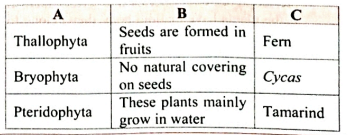 ,
, 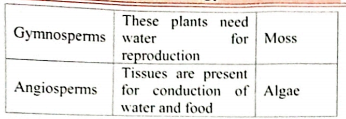
View SolutionMatch the following
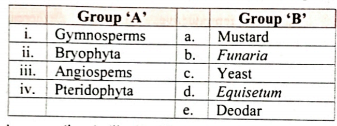
View SolutionWho proposed five kingdom system of classification.
View SolutionWhich criteria are used for the classification of plants? Explain with reason.
View SolutionAnswer the following
Which type of fungi are included in division thallophyta.
View SolutionAnswer the following questions:
Sketch , label and describe Spirogyra.
View SolutionAnswer the following questions:
Write the characteristics of the plants belonging to the division Bryophyta.
View SolutionSketch and label the figures of the following plants and explain them into brief.
Spirogyra
View SolutionAnswer the following questions:
Sketch and label the figures of the following and explain them in brief.
Funaria
View SolutionAnswer the following questions:
Sketch and label the figures of the following and explain them in brief.
Fern
View SolutionSketch and label the figures of the following plants and explain them into brief.
Spirogyra
View SolutionAnswer the following questions:
Write the characteristics of subkingdom phanerogams.
View SolutionAnswer the following
Give any four examples of division:
Thallophyta
View SolutionAnswer the following
Give any four examples of division:
Bryophyta
View SolutionAnswer the following
Give any four examples of division:
Pteridophyta
View SolutionAnswer the following
Give any four examples of division:
Gymnosperms
View SolutionAnswer the following
Give any four examples of division:
Angiosperms
View SolutionAnswer the following
Fibrous roots are present in which plants?
View SolutionAnswer the following
How seeds of gymnosperms differ from that of angiosperms?
View SolutionAnswer the following questions:
Write the paragraph in your own words about the ornamental plants called ferns.
View SolutionGiven scientifc reasons:
Green plants are called autotrophs.
View SolutionComplete the sentences and explain them:
(Angiosperms, gymnosperms, spores, bryophyta, thallophyta, zygote)
………..Plants have soft and fiber like body.
View SolutionComplete the sentences and explain them:
(Angiosperms, gymnosperms, spores, bryophyta, thallophyta, zygote)
…………is called the 'amphibian' of the plant kingdom.
View SolutionComplete the sentences and explain them:
(Angiosperms, gymnosperms, spores, bryophyta, thallophyta, zygote)
In pteridophytes, asexual reproduction occurs by ……..formation and sextual reproduction occurs by ……..formation.
View SolutionComplete the sentences and explain them:
(Angiosperms, gymnosperms, spores, bryophyta, thallophyta, zygote)
Male and female flowers of …….are borne on different sporophylls of the same plant.
View SolutionDistinguish between the following:
Thallphyta and Bryophyta.
View SolutionDistinguish between:
Dicots and Monocots
View SolutionDistinguish between cryptogams and phanerogams.
View SolutionComplete the given table.
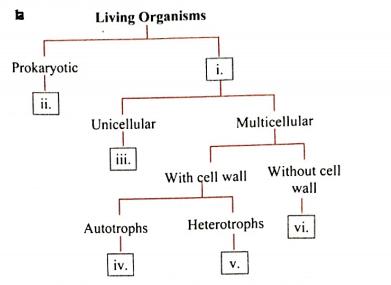
View SolutionComplete the given table.
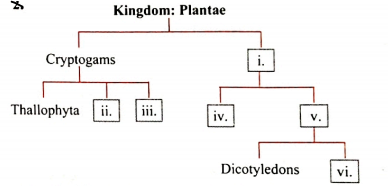
View SolutionQuestion based on paragraph
While playing in a garden, Rahul noticed some ornamental plants. When he observed them carefully, he found some Powdery spots on the posterior surface of leaflets of plant. He was curious to observe the flowers or fruits of these plants, but he could not find any of these.
If Rahul considers ‘the presence or absence of Organs’ as a criteria to classify this plant, which are the possible divisions?
View SolutionQuestion based on paragraph
While playing in a garden, Rahul noticed some omamental plants. When he observed them carefully, he found some Powdery spots on the posterior surface of leaflets of plant. He was curious to observe the flowers or fruits of these plants, but he could not find any of these.
Since, Rahul could not find any fruits or flowers, in which division he should place this plant?
View SolutionQuestion based on paragraph
While playing in a garden, Rahul noticed some ornamental plants. When he observed them carefully, he found some Powdery spots on the posterior surface of leaflets of plant. He was curious to observe the flowers or fruits of these plants, but he could not find any of these.
Can you guess the plant observed by Rahul in the garden?
View SolutionQuestion based on paragraph
While playing in a garden, Rahul noticed some ornamental plants. When he observed them carefully, he found some Powdery spots on the posterior surface of leaflets of plant. He was curious to observe the flowers or fruits of these plants, but he could not find any of these.
What is the use of powdery spots Present on posterior surface of leaflets?
View SolutionQuestion based on paragraph
While playing in a garden, Rahul noticed some ornamental plants. When he observed them carefully, he found some Powdery spots on the posterior surface of leaflets of plant. He was curious to observe the flowers or fruits of these plants, but he could not find any of these.
Give two more examples of plants belonging to same division.
View SolutionHow living organisms have been classified?
View SolutionWhich are the special cell organelles that differentiate plant cells from animal cells?
View SolutionSearch for a pond with greenish water. Collect some of the green fibres from the water. Put the fibres in a petridish and wash them clean with water. Put one of the fibres in a drop of water on a glass slide and spread it out straight. Put a cover-slip over the slide and observe under a compound microscope.
View SolutionYou may have seen a lush green soft carpet on old walls, bricks and rocks in the rainy season. Scrape it gently with a small ruler, observe it under a magnifying lens and discuss.
View SolutionYou may have seen ferns among the ornamental plants in a garden. Take a leaf of a fully grown fern and observe it carefully.
View SolutionAnswer the following questions:
What is the similarity between the plants of the groups, Thallophyta, Bryophyta and Pteridophyta irrespective of differences in their body structure. (Use your brain power)
View SolutionObserve garden plants like Cycas, christmas tree, hibiscus, Lilly, etc. and compare them. Note the similarities and differences between them. Which differences did you notice between gymnosperms and angiosperms?
View SolutionSoak the seeds of corns, beans, groundnut, tamarind, mango, wheat etc. in water for 8 to 10 hrs. After they are soaked, check each seed to see whether it divides into two equal halves or not and categorize them accordinly.
View SolutionChoose the correct alternative
Which among the following CANNOT be observed in Spirogyra?
View SolutionChoose the correct alternative
Well developed roots, stem and leaves are a feature of
View SolutionChoose the correct alternative
Which of the following is FALSE about Nephrolepis?
View SolutionChoose the correct alternative
________are also known as amphibians of plant kingdom.
View SolutionAnswer the following
Find the odd one out from the given figures.

View SolutionAnswer the following
Match the following

View SolutionAnswer the following
A group of non- flowering plants With well developed conducting system.
View SolutionAnswer the following
Complete the given analogy
Sargassum: Thallophyta Riccia: _______
View SolutionGive the scientific reasons
Chara is an autotrophic plant
View SolutionState whether the following statements are true or false. Correct the false statements:
Moss (Funaria) belongs to division bryophyta
View SolutionAnswer the following
What are the cryptogams? Give two examples of it.
View SolutionAnswer the following
Complete the given flow chart.

View SolutionAnswer the following
Observe the diagram and answer the given questions.
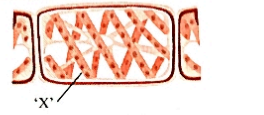
View SolutionAnswer the following
Identify the given figure.
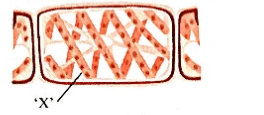
View SolutionAnswer the following
To which division does it belong?
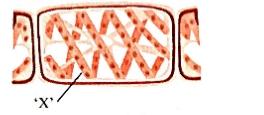
View SolutionAnswer the following
Both asexual and sexual reproduction occurs in pteridophytes’. Explain
View SolutionAnswer the following
Draw neat and labelled diagram of Marchantia and mention any two characteristics.
View SolutionWhich criteria are used for the classification of plants? Explain with reason.
View SolutionAnswer the following
Classify given examples of phanerogams into dicotyledans and monocotyledons.
Write the characteristics of each class.
Examples: Banana, Rice, Mustard, Coriander, Maize, Groundnut, wheat, Coconut, Tamarind, Bamboo. Coconut,
View Solution
EXERCISE questions and complete solutions for chapter CLASSIFICATION OF PLANTS of TARGET PUBLICATION of Class 9